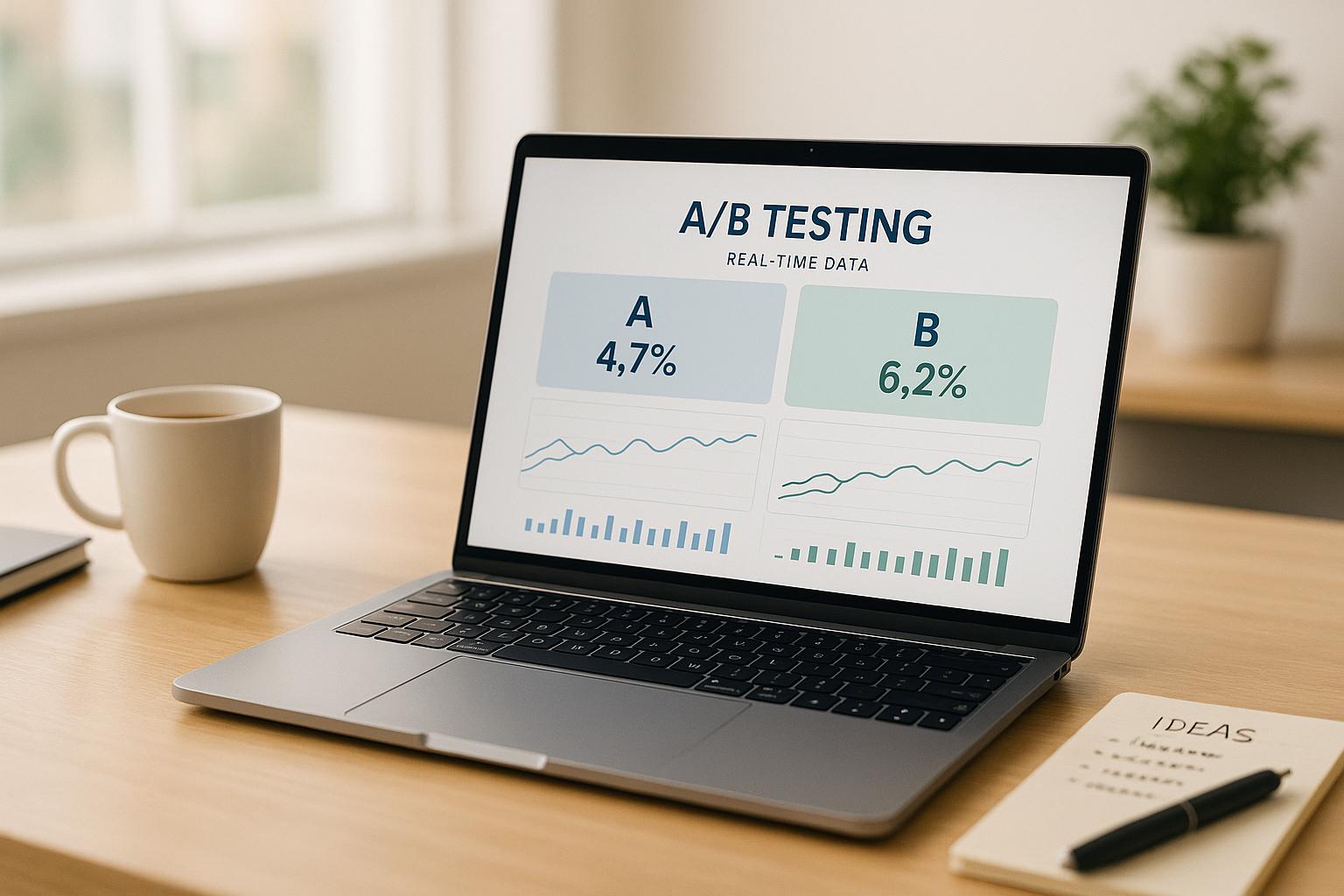AI anomaly detection helps marketing teams spot unusual patterns in their data instantly, preventing costly mistakes and improving campaign performance. It works by analyzing metrics like website traffic, conversion rates, and ad spend in real-time, alerting teams when something deviates from the norm. This allows for quick fixes and smarter decisions.
Key Takeaways:
- Real-time monitoring: Detects issues immediately.
- Cost savings: Reduces marketing costs by up to 30%.
- Actionable insights: Helps refine campaigns and fix problems fast.
How It Works:
- Data Collection: Gathers data from marketing channels (social media, email, website).
- Data Cleaning & Transformation: Prepares data for analysis.
- AI Algorithms: Uses methods like Isolation Forest, One-Class SVM, and Autoencoders to detect anomalies.
- Dynamic Normal Ranges: Adjusts thresholds based on historical and real-time data.
Benefits:
- Faster problem-solving (e.g., fixing ad misconfigurations in hours instead of days).
- Improved ROI (10–20% boost in conversions and 15–25% lower acquisition costs).
To get started, integrate AI tools with platforms like Google Analytics or Adobe Analytics, set up alert systems, and monitor metrics to act on insights quickly.
Core Components of AI Anomaly Detection
Data Processing Steps
AI anomaly detection starts with processing data to ensure it’s accurate and ready for analysis. Data is collected from various marketing channels such as social media metrics, email campaign performance, and website analytics. This raw data then goes through several key steps.
First, data cleaning is performed to correct errors and fill in missing values. Studies show that organizations with strong data cleaning practices can enhance data quality by up to 80%, leading to more accurate AI predictions.
Next, data transformation takes place. This step involves normalizing and aggregating data into a consistent format, making it suitable for the algorithms that follow.
Types of AI Algorithms Used
Once the data is clean and standardized, AI algorithms step in to detect anomalies:
- Statistical Methods: These analyze historical data patterns to pinpoint outliers.
- Machine Learning Models: Techniques like Isolation Forest and One-Class SVM identify irregularities in large datasets.
- Neural Networks: Autoencoders are used to uncover subtle anomalies that might go unnoticed with simpler methods.
"Machine learning algorithms like Isolation Forest and One-Class SVM are essential for identifying anomalies in large datasets, allowing marketers to react swiftly to potential issues." - Dr. Jane Smith, Data Scientist at Marketing Insights Inc.
A practical example comes from Adobe Analytics, which adopted machine learning in 2022 for e-commerce anomaly detection. Their use of Isolation Forest algorithms led to a 25% improvement in spotting fraudulent transactions by flagging unusual purchasing behaviors.
Setting Normal Data Ranges
AI systems also establish and update "normal" ranges for marketing metrics. These ranges adapt dynamically as new data comes in, ensuring the system stays relevant.
In January 2023, Adobe Analytics showcased this ability when their AI system helped a major retailer detect an unexpected drop in online sales. The system's dynamic thresholds quickly identified the issue - a website glitch - allowing the retailer to fix it and recover $1.5 million in potential lost revenue.
Dynamic data ranges are defined through:
- Analyzing historical performance data
- Using statistical methods like mean, median, and standard deviation
- Employing machine learning to account for seasonal trends
- Real-time monitoring of ongoing marketing activities
For optimal results, marketing teams should regularly update their baseline datasets and incorporate team feedback to refine the AI’s understanding of normal patterns. This ensures timely and relevant alerts that align with current trends.
Adding AI Anomaly Detection to Marketing
Connecting with Analytics Tools
Platforms like Google Analytics and Adobe Analytics now offer AI-powered features to help identify unusual patterns. According to the Marketing Analytics Tools Directory, combining data from multiple sources can improve anomaly detection.
Here’s how to get started:
- API configuration: Connect your platforms for seamless data flow.
- Data source mapping: Align data points across tools for consistency.
- Permission settings: Ensure proper access controls for secure integration.
Creating Alert Systems
Alert systems allow teams to respond quickly to unexpected changes. For example, in 2023, Quantum Metric's marketing team noticed a 15% drop in conversion rates. By acting swiftly, they managed to recover 25% of the lost conversions within two weeks.
Dashboard Setup
- Set up dashboards for real-time monitoring.
- Define custom thresholds to highlight key anomalies.
- Add visual indicators for easy interpretation.
Notification Channels
- Use email alerts for immediate updates.
- Integrate with messaging apps like Slack or Teams.
- Enable mobile notifications for on-the-go responses.
"Real-time anomaly detection is crucial for marketing teams to respond swiftly to unexpected changes in data, ensuring campaigns remain effective." - John Doe, Chief Data Scientist, Marketing Analytics Inc.
These systems provide the foundation for quick, informed decision-making.
Using AI Findings for Decisions
Once alerts are triggered, the next step is to act on the insights. Businesses using AI-based analytics often report a 10-20% boost in marketing ROI. For instance, in 2023, an e-commerce company leveraged Google Analytics’ AI capabilities to identify and resolve a regional traffic drop, recovering 25% of the lost visitors.
| Decision Type | AI Input | Action |
|---|---|---|
| Campaign Adjustments | Performance anomalies | Shift budgets strategically |
| Content Strategy | Engagement patterns | Optimize content formats |
| Technical Issues | Traffic fluctuations | Improve website infrastructure |
"Integrating AI with our analytics tools has transformed how we detect anomalies and respond to market changes." - Jane Doe, Marketing Director, E-commerce Company
To make the most of these tools, regularly review AI-generated insights and establish clear response protocols.
sbb-itb-5174ba0
Anomaly Detection for Digital Marketing
Measuring Results
After integrating AI, use specific metrics to assess how your campaigns have improved.
Performance Metrics
Track the impact of AI anomaly detection with key indicators like conversion rates and customer acquisition costs. Many organizations report increases of 10–20% in conversion rates and reductions of 15–25% in acquisition costs after implementing AI tools. Start by setting baseline metrics before deployment, then monitor regularly to separate useful insights from noise.
| Metric Type | What to Measure | Target Improvement |
|---|---|---|
| Campaign Performance | Conversion rates, click-through rates | 10–20% increase |
| Cost Efficiency | Customer acquisition costs, ad spend | 15–25% reduction |
These benchmarks make it easier to compare results before and after AI integration.
Results Before and After
Quantum Metric’s Q1 2023 data highlights the benefits of AI anomaly detection. Following implementation, their marketing team achieved a 25% boost in conversion rates and cut customer acquisition costs by 15%. This directly contributed to revenue growth.
"AI anomaly detection allows marketing teams to pivot quickly, ensuring that campaigns remain effective and aligned with customer behavior." - John Doe, Chief Data Scientist at Quantum Metric
These results show how real-time alerts can drive quick, impactful decisions.
Return on Investment
Determine ROI by weighing the costs of AI implementation - such as licensing, training, and integration - against the financial gains from improved performance. For example, in Q1 2023, Quantum Metric generated $500,000 in extra revenue within three months of adopting AI anomaly detection. Some companies report ROI increases as high as five times compared to older methods. These numbers demonstrate how AI tools can continually refine marketing strategies for better outcomes.
Summary
Key Benefits
AI anomaly detection transforms marketing analytics by processing data in real time. It reduces analysis time by up to 70% and improves campaign performance by 20–30%, thanks to its ability to instantly identify irregularities that might go unnoticed. This automation supports smarter, faster decisions while cutting down on manual monitoring.
| Benefit | Impact |
|---|---|
| Faster Analysis | Cuts analysis time by 70% |
| Better Campaigns | Boosts effectiveness by 20–30% |
| Quicker Response | Speeds up reactions by 50% |
How to Start
With these benefits in mind, implementing AI anomaly detection becomes a practical step. Resources like the Marketing Analytics Tools Directory can help you find tools that work with your existing systems.
"AI anomaly detection not only saves time but also uncovers insights that can significantly improve marketing outcomes." – John Doe, Data Scientist at Marketing Innovations
To get started, choose tools that align with your analytics, define baseline metrics, and set up real-time alerts. Platforms like OWOX BIO and Adobe Analytics offer anomaly detection starting at $100 per month. Following these steps can streamline your monitoring and deliver instant improvements to your marketing efforts.


